Module 1: IB Recruiting
Recruiting | Behaviorals | Accounting | Enterprise Value / Comparables | DCF | M&A | LBO| Market questions | Brain teasers
It all begins with having a REAL plan for your IB recruitment cycle
Breaking into investment banking is fiercely competitive—but with the right plan, you can set yourself apart from day one. This module lays the groundwork for your entire recruiting journey, from mastering behavioral interviews and technicals to understanding the structure of the industry, key timelines, and how different banks and groups operate. Whether you’re a student aiming for your first analyst role or an MBA targeting a lateral move, you’ll learn exactly what it takes to stand out—starting with your resume, cover letter, and networking strategy. If you’re serious about IB, this is where the real prep begins.
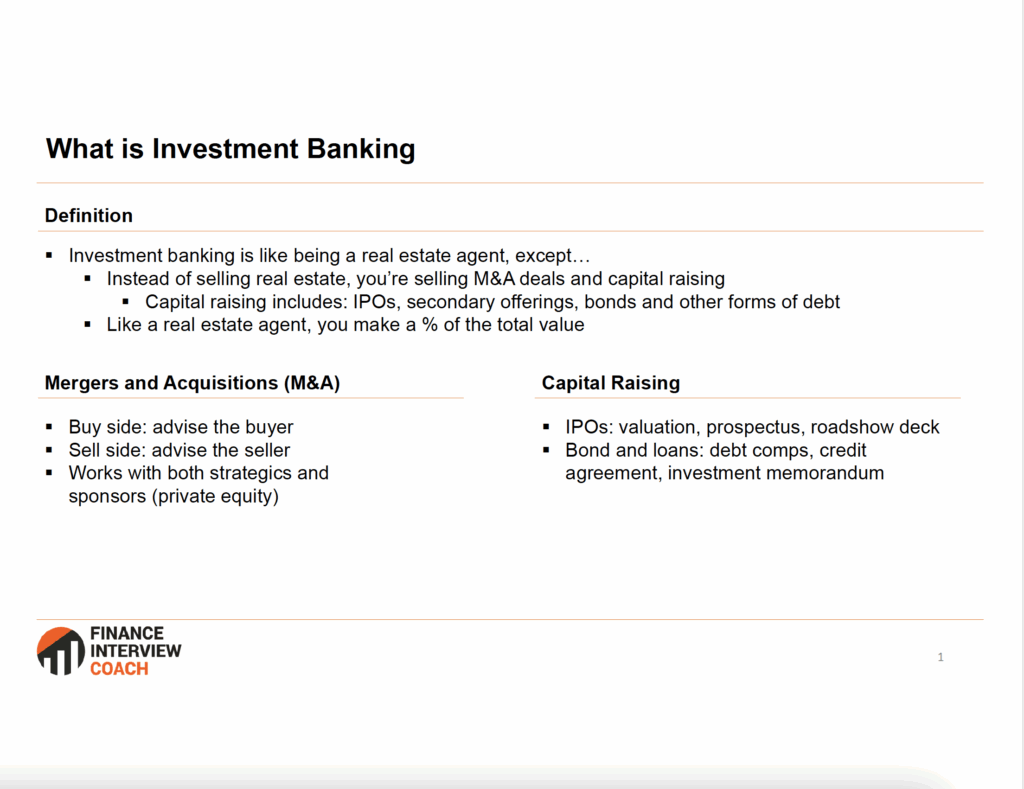
Lesson 1
Investment Banking 101
This is a nice opening anticdote – rework into a sales copy. [You’d be surprised at the number of people who don’t know what Investment Banking is about….]
In this Lesson:
Core Function: Advise companies on mergers, acquisitions, and capital raising.
Key Services: M&A advisory, IPOs, debt offerings, restructuring, and valuations.
Client Types: Corporations, governments, and financial sponsors like private equity.
Revenue Model: Earn fees from completed deals, underwriting, and advisory retainers.
Analyst Responsibilities: Build models, create pitchbooks, run valuations, and conduct research.
Team Structure: Analyst → Associate → VP → Director → Managing Director.
This is a nice opening anticdote – rework into a sales copy. [You’d be surprised at the number of people who don’t know what Investment Banking is about….]
In this Lesson:
- What is Investment Banking
- What is M&A & How does it Work (From Deal to Auction, Rounds 1-3, CIM, LOI’s, IOI, SPA’s)
- IPO’s – (Research, Valuations, Modeling, Due Diligence, Roadshow Decks, Prospectus’)
- Debt Raising – Bonds (interest, terms, and decks) and Loans (Due diligence, Corporate Banking Groups, & syndication)
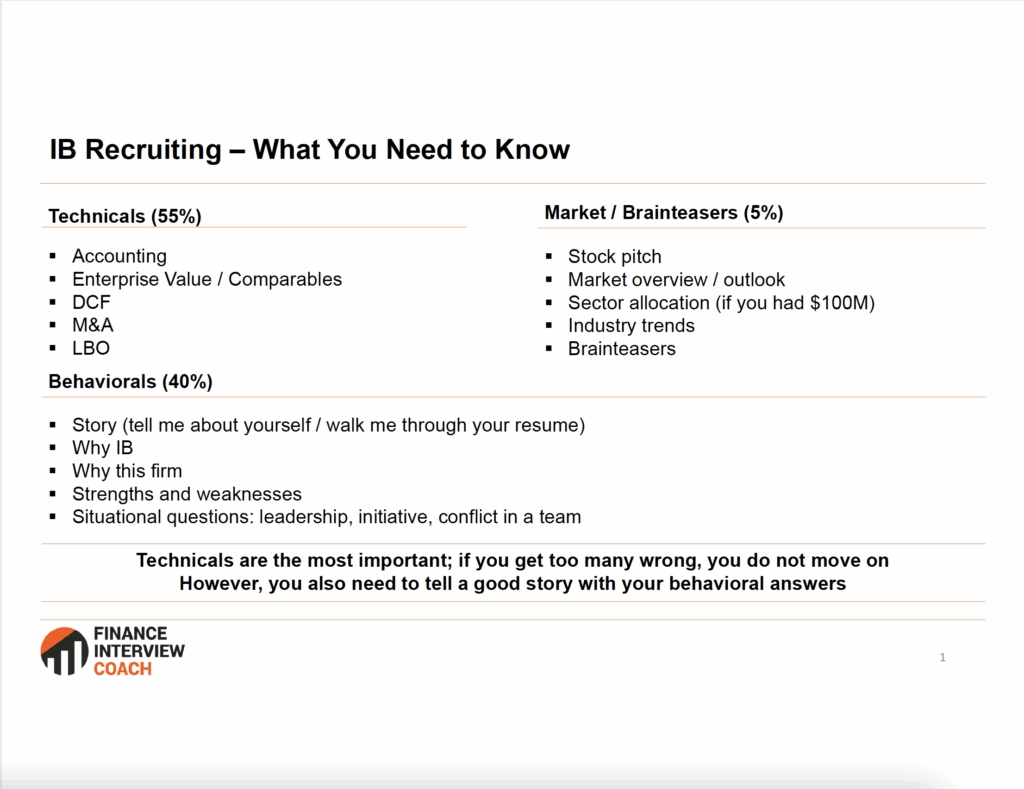
Lesson 2
What you need to Know to break into Investment Banking
Whether you’re aiming for a top-tier bulge bracket firm or an elite boutique, understanding the recruiting process is essential to getting your foot in the door.
In this Lesson:
Behaviorals: Story, why IB, why this firm
Accounting: How does XYZ (PP&E, net working capital) affect the 3 statements?
Enterprise Value / Comps: Equity value vs. enterprise value, comparables and precedents
DCF: UFCF vs LFCF, WACC, cost of equity, beta, terminal value
M&A: Synergies, rationale, earnings yield, merger model method
LBO: what makes a good LBO target, senior vs. junior debt, paper LBO
Whether you’re aiming for a top-tier bulge bracket firm or an elite boutique, understanding the recruiting process is essential to getting your foot in the door.
In this Lesson:
- Why most important part of recruiting is technical questions
- IB is Accounting, Enterprise Value Comparables, DCF, LBO, and M&A
- How do the large banks differ than the smaller banks?
- How important are behaviourals? The “Tell me about yourself.” & using the CAR framework.
- Stock Pitch, Market Overview, & Sector Allocation Questions
- Understanding the Quantitative vs Qualitative breakdown (Accounting, Enterprise Value, DCF, M&A, LBO)
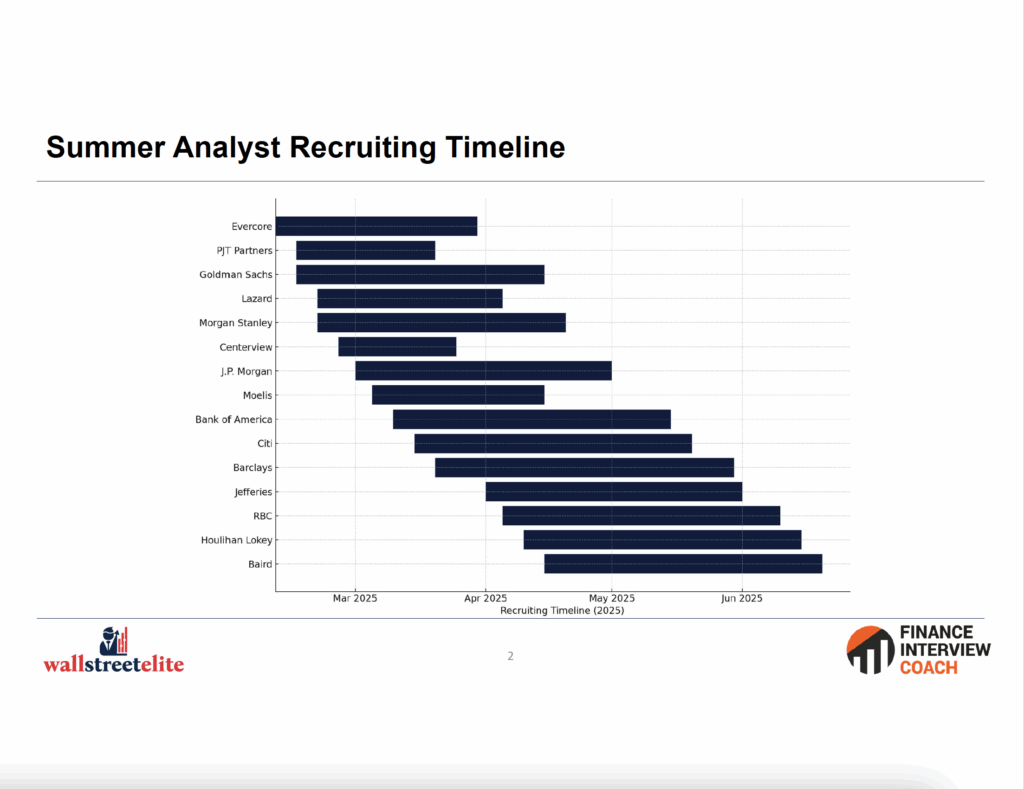
Lesson 3
Recruiting Timelines
Whether you’re aiming for a top-tier bulge bracket bank or an elite boutique advisory firm, one thing is certain: timing is everything. In investment banking, recruiting cycles are aggressive and structured—and missing a deadline can mean missing your shot entirely. Undergraduates often need to begin preparing 18–24 months ahead, MBA candidates move within a tighter window during their first year, and lateral opportunities emerge unpredictably throughout the year. From accelerated interview tracks to standard Superday formats, the process varies widely by level—but the key to breaking in is understanding exactly when each phase happens and how to best position yourself.
In this Lesson:
Sophomore Summer: Start networking for junior summer internships.
Junior Year: On-cycle recruiting begins early (spring/summer prior).
Accelerated vs. Regular: BBs and EBs often recruit on an accelerated timeline
MBA Recruiting: Starts early fall of Year 1 and moves quickly.On-Cycle vs. Off-Cycle: On-cycle is rapid and condensed; off-cycle is longer and less structured.
- Application Timing: Resumes often due months before interviews — be ready early.
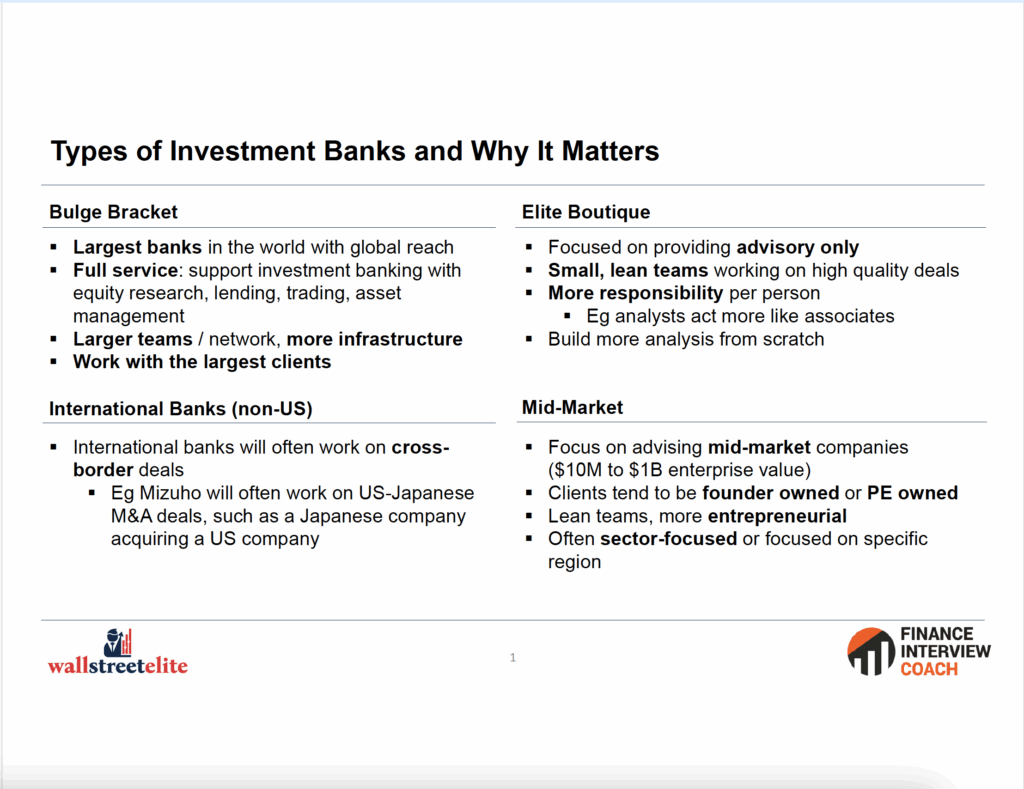
Lesson 4
Bulge Bracket, International, and mid-market Banks
Whether you’re aiming for a globally recognized bulge bracket bank or a regionally focused mid-market firm, understanding the different types of investment banks—and what they’re known for—is essential to choosing the right fit and navigating your career path in finance. Each type of firm offers distinct advantages, from deal exposure to team structure to industry specialization.
In this Lesson:
Bulge Brackets (BB): Large, global firms with high volume and structured training.
Elite Boutiques (EB): Smaller, M&A-focused, leaner deal teams, often better compensation.
Middle Market (MM): Broader analyst exposure, smaller deal sizes, faster responsibility.
International Banks: Global presence with varied U.S. recruiting pace and product focus.
Brand vs. Fit: Choose based on long-term goals — not just prestige.
Exit Opportunities: All bank types can lead to strong buy-side or corporate roles.
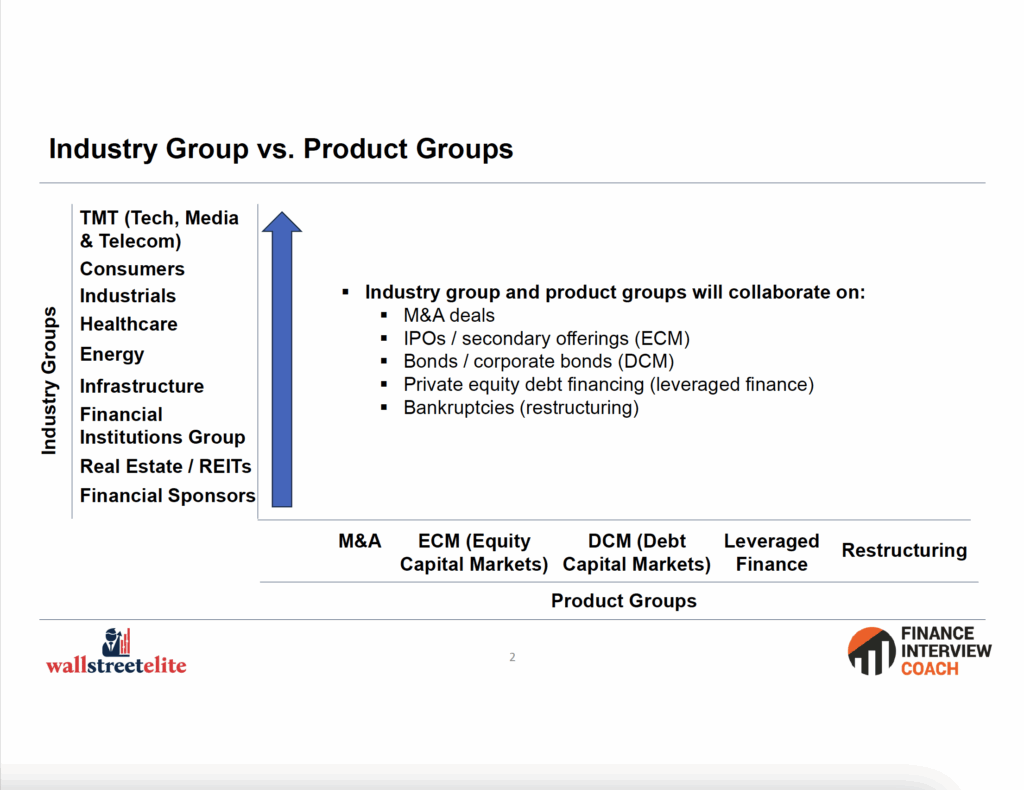
Lesson 5
Industry Groups and Product Groups
Whether you’re pitching an M&A deal in consumer retail or helping take a tech company public, understanding the roles of industry and product groups is essential to knowing how deals get sourced and executed.
In this Lesson:
Industry Groups: Focus on sectors like Tech, Healthcare, Energy, Industrials, etc.
Product Groups: Focus on deal types like M&A, LevFin, Restructuring.
Coverage vs. Execution: Industry groups often manage client relationships; product groups execute deals.
Placement: Some firms assign directly; others allow rotation before placement.
Geography Matters: Group offerings vary by office (e.g., M&A in NYC, Tech in SF).
Recruiting Tip: Know what each group does and tailor your interest accordingly.
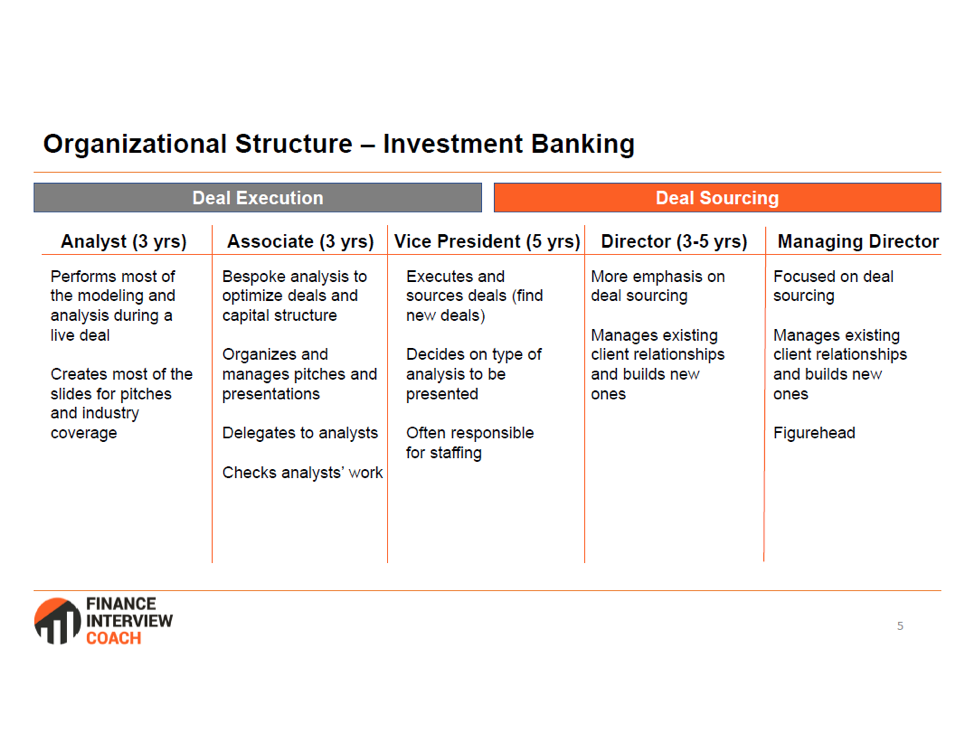
Organizational Hierarchy (Coming Soon)
In investment banking, understanding the organizational hierarchy is essential for knowing how deal teams function and how responsibilities scale with seniority. This lesson covers each role, from Analysts to Managing Directors, and explains how they collaborate to source, pitch, and execute transactions.
In this lesson:
- Analyst: Entry-level role focused on modeling, research, and presentation support.
- Associate: Manages analysts, reviews work, and starts leading client communication.
- Vice President: Coordinates deal execution, manages internal/external processes.
- Director / Executive Director: Develops client relationships and pitches.
- Managing Director: Sources deals, owns client relationships, drives firm revenue.
- Team Dynamics: Analysts typically work under Associates and VPs on deal teams.
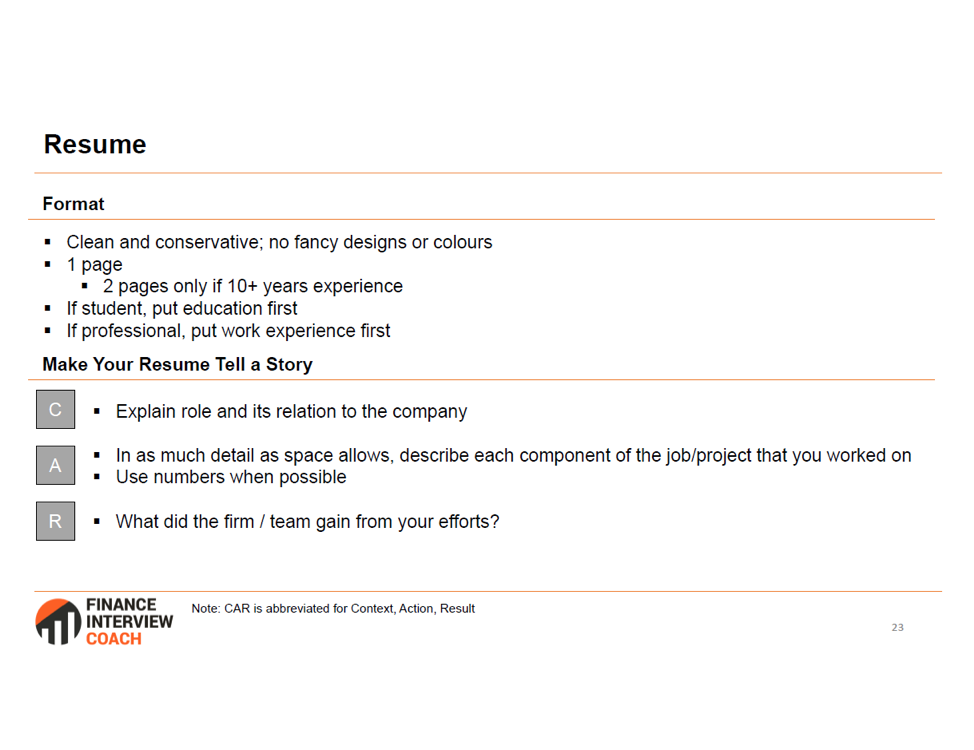
Resume (Coming Soon)
Your resume is often your first impression in investment banking recruiting, so it must be sharp, concise, and tailored to the role. This lesson covers how to structure and customize your resume to highlight leadership, technical skills, and finance-relevant experience, all while avoiding common pitfalls.
In this lesson:
- Format: One page, reverse-chronological, clean and professional design.
- Content Focus: Highlight leadership, results, finance/quantitative experience.
- Bullet Structure: Start with strong verbs, include metrics, and focus on outcomes.
- Customization: Tailor resume to highlight finance-relevant skills and experiences.
- Technical Proficiency: Include Excel, PowerPoint, modeling, or relevant tools.
- Proofreading: Typos or errors can lead to instant rejection – get reviews.
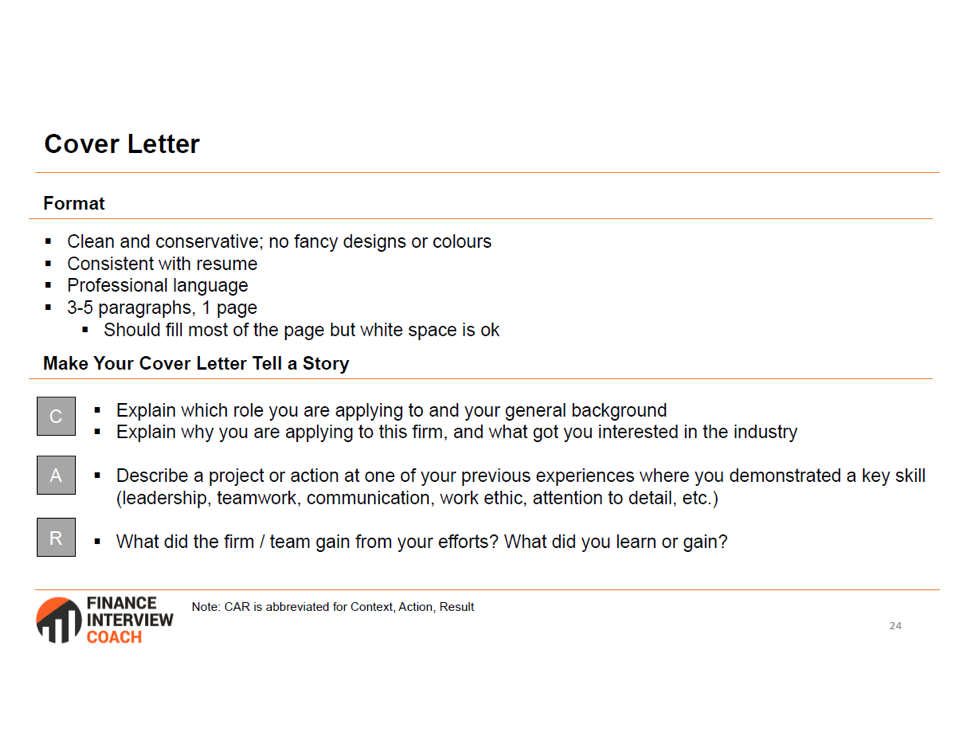
Cover Letter (Coming Soon)
A well-written cover letter helps you stand out by showing genuine interest and fit for both the role and the firm. This lesson covers how to craft a focused, personalized letter that explains why you want to work in IB, why this firm, and what you bring to the table, while keeping it concise, confident, and professional.
In this Lesson:
- Length: Keep to 3–4 concise paragraphs – never more than one page.
- Opening: State the role, how you learned about it, and a clear interest in the firm.
- Body: Explain why IB, why this firm, and what you uniquely bring.
- Details: Mention specific interactions, deals, or firm attributes where possible.
- Tone: Confident but humble – focus on value, not flattery.
- Finish Strong: End with a clear ask for an interview and appreciation for consideration.
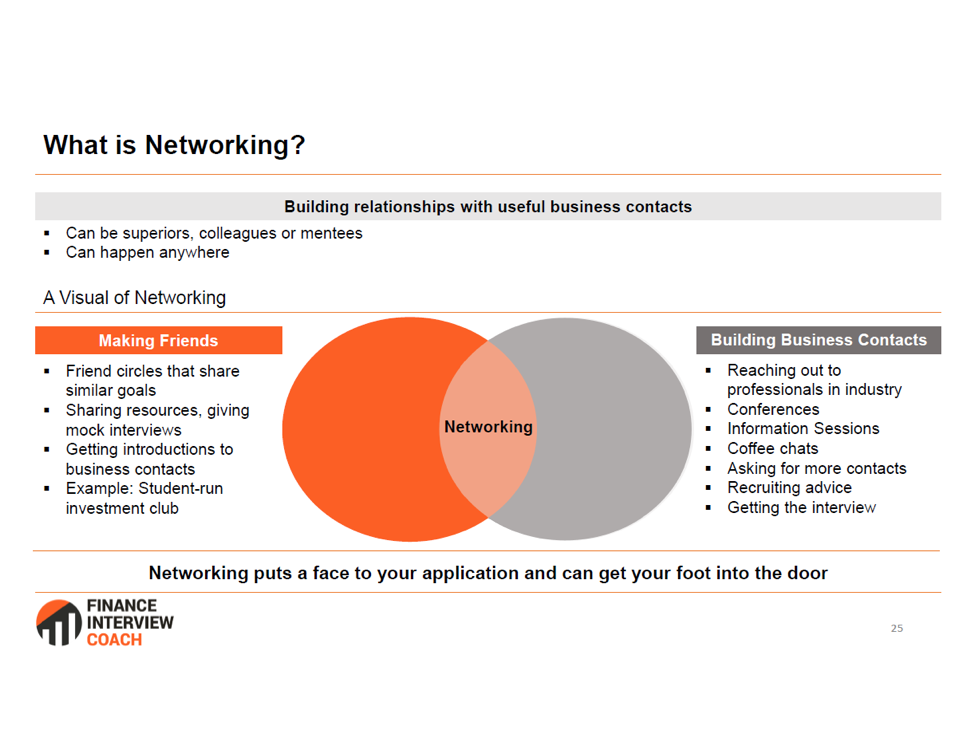
Networking (Coming Soon)
Networking is one of the most powerful tools in breaking into investment banking, and often the difference-maker in securing interviews. This lesson outlines how to build authentic relationships through alumni outreach, coffee chats, and strategic follow-ups, while keeping your process organized and focused on securing referrals.
In this lesson:
- Start Early: Begin building relationships 6–12 months ahead of applications.
- Leverage Alumni: School alumni in IB are your most reliable contacts.
- Coffee Chats: Request 20-minute calls to learn and show genuine interest.
- Follow-Up: Send thank-you notes, and keep warm contacts updated.
- Track Progress: Use a spreadsheet to log contacts, outreach, and key notes.
- Referral Strategy: A warm internal referral often leads to interview opportunities.
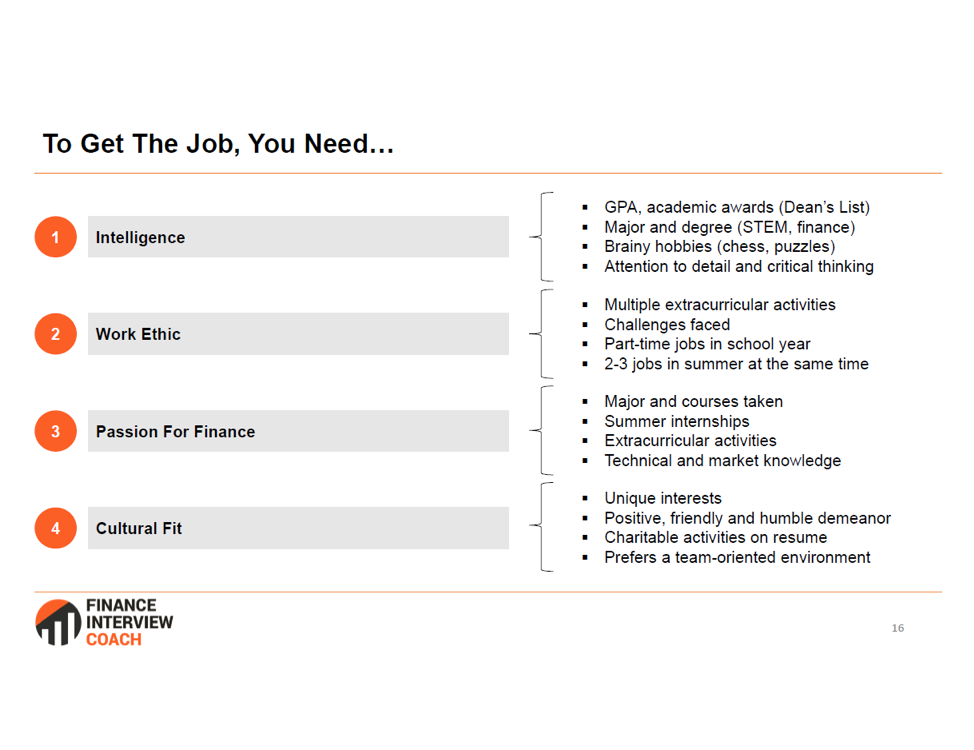
Tips for MBA students
MBA recruiting for investment banking is fast-paced and competitive, making preparation and positioning critical from day one. This lesson covers how to craft your story, build meaningful connections, and navigate on-campus recruiting; often a key to landing a full-time offer.
In this lesson:
- Storytelling: Link your pre-MBA background to your IB interest with a clear narrative.
- Early Prep: Master technicals and behavioral questions before recruiting begins.
- Networking: Consistent, high-quality outreach during the fall is critical.
- Campus Presence: Engage with clubs, alumni panels, and recruiter events.
- Targeting: Know which banks prioritize your MBA program – tailor outreach.
- Summer Offer: Most full-time roles come from the summer internship – prioritize it.
Josh is a great mentor and was a crucial component of my career development early on, and the guidance he provided me on financial modeling and LBO modeling gave me a step up in both recruiting and work. He is extremely competent with regards to teaching financial concepts for individuals both new and familiar with finance, and is always happy to share honest advice. They are both genuinely care about your success and I would recommend him to anyone interested in developing the necessary skills to pursuing a career in finance early on.
Daniel Cheung
Investment Analyst at Highbridge Capital
Start your IB prep today.
Don’t wait to get ahead—start your IB prep today.